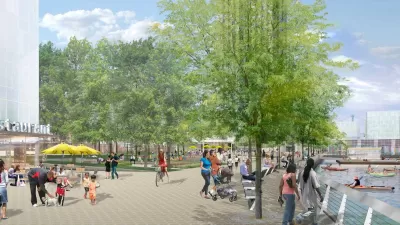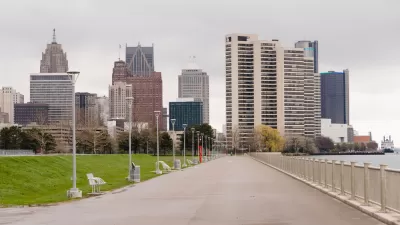A 52-acre development planned for Washington, D.C.'s isolated Southwest Quadrant hopes to create a 21st century waterfront by embracing the elements that have contributed to creating lively urban waterfronts for centuries, reports Kriston Capps.
Ambitious new development plans for D.C.'s neglected Southwest Quadrant waterfront are going old-school, by relying on the qualities - dense mixed-use development and active uses on the water - that have made for lively urban waterfronts for centuries. Yet, this will be "a waterfront for the 21st century," say its developers, Hoffman-Madison Marquette, and designers at EE&K, a Perkins Eastman Company, the firm behind the master plan for "The Wharf."
Although America's active waterfronts developed as commercial and mercantile spaces, the changing demands of maritime shipping and euclidean zoning led to their disuse. D.C.'s plans hope to bring the city back to the city's edge, with commercial activity extending all the way up to water's edge, and even into the water, with the redevelopment of the area's piers and marinas. The eventual hope is to not only attract local Washingtonians, but also become a center for tourism.
"Looming water-level questions notwithstanding, the question for the 21st-century waterfront is economic: How do planners restore the once-industrial character of the waterfront?" questions Capps. "Washington's Southwest waterfront poses one answer: take the zone out of the question altogether, and make it another neighborhood like you'd find anywhere."
FULL STORY: Can D.C. Lead the Way to a 21st Century Waterfront?

Study: Maui’s Plan to Convert Vacation Rentals to Long-Term Housing Could Cause Nearly $1 Billion Economic Loss
The plan would reduce visitor accommodation by 25,% resulting in 1,900 jobs lost.

North Texas Transit Leaders Tout Benefits of TOD for Growing Region
At a summit focused on transit-oriented development, policymakers discussed how North Texas’ expanded light rail system can serve as a tool for economic growth.

Why Should We Subsidize Public Transportation?
Many public transit agencies face financial stress due to rising costs, declining fare revenue, and declining subsidies. Transit advocates must provide a strong business case for increasing public transit funding.

How to Make US Trains Faster
Changes to boarding platforms and a switch to electric trains could improve U.S. passenger rail service without the added cost of high-speed rail.

Columbia’s Revitalized ‘Loop’ Is a Hub for Local Entrepreneurs
A focus on small businesses is helping a commercial corridor in Columbia, Missouri thrive.

Invasive Insect Threatens Minnesota’s Ash Forests
The Emerald Ash Borer is a rapidly spreading invasive pest threatening Minnesota’s ash trees, and homeowners are encouraged to plant diverse replacement species, avoid moving ash firewood, and monitor for signs of infestation.
Urban Design for Planners 1: Software Tools
This six-course series explores essential urban design concepts using open source software and equips planners with the tools they need to participate fully in the urban design process.
Planning for Universal Design
Learn the tools for implementing Universal Design in planning regulations.
City of Santa Clarita
Ascent Environmental
Institute for Housing and Urban Development Studies (IHS)
City of Grandview
Harvard GSD Executive Education
Toledo-Lucas County Plan Commissions
Salt Lake City
NYU Wagner Graduate School of Public Service





























